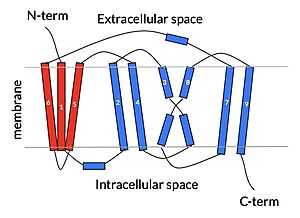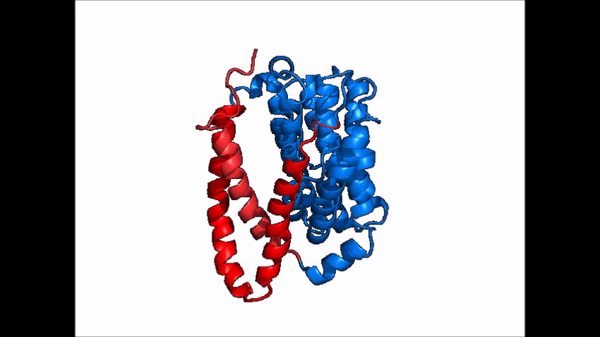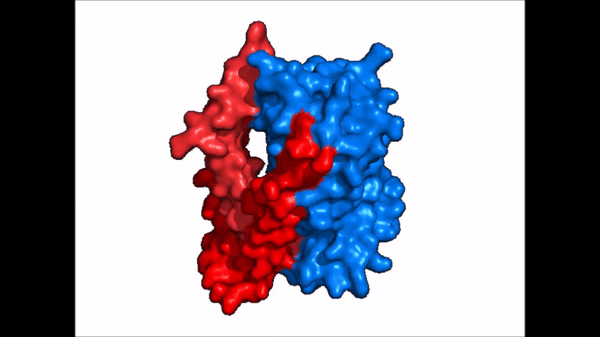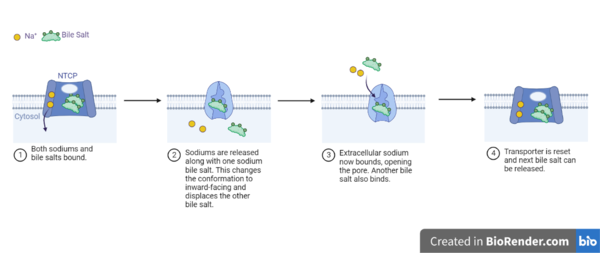Sandbox Reserved 1794
From Proteopedia
(Difference between revisions)
| Line 14: | Line 14: | ||
=== Overview === | === Overview === | ||
Sodium Taurocholate Co-Transporting Polypeptide, or NTCP, is one continuous polypeptide chain consisting of a total of 9 transmembrane α helices (TM1-9). The N-terminus of the polypeptide chain is found on the extracellular side of the plasma membrane while the C-terminus is located on the intracellular side. There are two distinct domains within the quaternary structure of NTCP: a <scene name='95/952722/Ntcp_core_domain-_blue/3'>core domain</scene> <font color='#6060ff'><b>(blue)</b></font> and a <scene name='95/952722/Ntcp_panel_domain-_red/2'>panel domain</scene> <font color='red'><b>(red)</b></font>, both being a part of the same polypeptide chain. The core domain includes 6 transmembrane α helices (TM2-4 and TM7-9) and demonstrates two-fold pseudosymmetry while the panel domain consists of 3 transmembrane α helices (TM1 and TM5-6) and does not display symmetry. Within the core domain, there is a unique crossover between TM-3 and TM-8 that is known as the <scene name='95/952722/Ntcp_x_motif/5'>X motif</scene>. This motif is important because this is where the transporter's substrate binding site is located and within this motif lies essential residues that aid in the conformational change that NTCP undergoes. | Sodium Taurocholate Co-Transporting Polypeptide, or NTCP, is one continuous polypeptide chain consisting of a total of 9 transmembrane α helices (TM1-9). The N-terminus of the polypeptide chain is found on the extracellular side of the plasma membrane while the C-terminus is located on the intracellular side. There are two distinct domains within the quaternary structure of NTCP: a <scene name='95/952722/Ntcp_core_domain-_blue/3'>core domain</scene> <font color='#6060ff'><b>(blue)</b></font> and a <scene name='95/952722/Ntcp_panel_domain-_red/2'>panel domain</scene> <font color='red'><b>(red)</b></font>, both being a part of the same polypeptide chain. The core domain includes 6 transmembrane α helices (TM2-4 and TM7-9) and demonstrates two-fold pseudosymmetry while the panel domain consists of 3 transmembrane α helices (TM1 and TM5-6) and does not display symmetry. Within the core domain, there is a unique crossover between TM-3 and TM-8 that is known as the <scene name='95/952722/Ntcp_x_motif/5'>X motif</scene>. This motif is important because this is where the transporter's substrate binding site is located and within this motif lies essential residues that aid in the conformational change that NTCP undergoes. | ||
| + | |||
| + | === Binding Sites === | ||
| + | ==== Sodium ==== | ||
| + | NTCP, among others in the SLC10 family, have <scene name='95/952721/Sodium_binding/2'>two sodium binding sites</scene>. Many polar and negatively charged residues are characteristic of these active sites. The high level of conservation among sodium binding placement and interacting residues suggests sodium binding is coupled to bile salt transport. Additional mutations in the X-motif near sodium binding sites have shown that bile salt transport function is lost. This suggests sodium binding impacts bile salt binding. | ||
| + | <Ref name = "Goutam"> Goutam, K., Ielasi, F.S., Pardon, E. et al. Structural basis of sodium-dependent bile salt uptake into the liver. Nature 606, 1015–1020 (2022). [https://doi.org/10.1038/s41586-022-04723-z DOI: 10.1038/s41586-022-04723-z]. </Ref> It is understood that sodium binding and release facilitates changes from open-pore to inward-facing states of NTCP. The inward-facing state is favored in the absence of sodium ions, while the open-pore state is favored in the presence of sodium ions. This also allows for sodium concentrations to regulate the uptake of taurocholates. When intracellular sodium levels are higher, the open-pore state is favored allowing for the diffusion of taurocholates. However, when extracellular sodium levels are high, the inward-facing state is favored preventing diffusion of taurocholates. <ref name="Goutam"/> | ||
=== Conformational Change === | === Conformational Change === | ||
| Line 20: | Line 25: | ||
<table align='right' border='0' width='4' cellpadding='0' bgcolor='#d0d0d0' hspace='0'><tr><td rowspan='2'> </td><td bgcolor='#e8e8e8'>[[Image:Surface_NTCP_confchange.gif]]</td></tr><tr><td bgcolor='#e8e8e8'>Cartoon representation of NTCP conformational change.</td></tr></table> | <table align='right' border='0' width='4' cellpadding='0' bgcolor='#d0d0d0' hspace='0'><tr><td rowspan='2'> </td><td bgcolor='#e8e8e8'>[[Image:Surface_NTCP_confchange.gif]]</td></tr><tr><td bgcolor='#e8e8e8'>Cartoon representation of NTCP conformational change.</td></tr></table> | ||
NTCP exists in two different conformations; the inward-facing conformation and the <scene name='95/952722/Ntcp_open_pore/1'>open pore conformation</scene>. In order to transport bile salts across the plasma membrane of hepocytes, NTCP must undergo the conformational change from inward facing to open pore. This movement consists of the core and panel domains both rotating 20 degrees and the panel domain moving 5 angstroms away from the core domain, which remains relatively rigid. This conformational change reveals two sodium ion binding sites as well as a pore in the membrane that bile salts can travel through. This movement of the panel domain is facilitated by proline and glycine residues located in the connector loops between the panel and core domains. These residues act as hinges that assist in the movement of the panel domain away from the core domain. | NTCP exists in two different conformations; the inward-facing conformation and the <scene name='95/952722/Ntcp_open_pore/1'>open pore conformation</scene>. In order to transport bile salts across the plasma membrane of hepocytes, NTCP must undergo the conformational change from inward facing to open pore. This movement consists of the core and panel domains both rotating 20 degrees and the panel domain moving 5 angstroms away from the core domain, which remains relatively rigid. This conformational change reveals two sodium ion binding sites as well as a pore in the membrane that bile salts can travel through. This movement of the panel domain is facilitated by proline and glycine residues located in the connector loops between the panel and core domains. These residues act as hinges that assist in the movement of the panel domain away from the core domain. | ||
| - | |||
| - | === Binding Sites === | ||
| - | ==== Sodium ==== | ||
| - | NTCP, among others in the SLC10 family, have <scene name='95/952721/Sodium_binding/2'>two sodium binding sites</scene>. Many polar and negatively charged residues are characteristic of these active sites. The high level of conservation among sodium binding placement and interacting residues suggests sodium binding is coupled to bile salt transport. Additional mutations in the X-motif near sodium binding sites have shown that bile salt transport function is lost. This suggests sodium binding impacts bile salt binding. | ||
| - | <Ref name = "Goutam"> Goutam, K., Ielasi, F.S., Pardon, E. et al. Structural basis of sodium-dependent bile salt uptake into the liver. Nature 606, 1015–1020 (2022). [https://doi.org/10.1038/s41586-022-04723-z DOI: 10.1038/s41586-022-04723-z]. </Ref> It is understood that sodium binding and release facilitates changes from open-pore to inward-facing states of NTCP. The inward-facing state is favored in the absence of sodium ions, while the open-pore state is favored in the presence of sodium ions. This also allows for sodium concentrations to regulate the uptake of taurocholates. When intracellular sodium levels are higher, the open-pore state is favored allowing for the diffusion of taurocholates. However, when extracellular sodium levels are high, the inward-facing state is favored preventing diffusion of taurocholates. <ref name="Goutam"/> | ||
==== Bile Salt ==== | ==== Bile Salt ==== | ||
Revision as of 16:55, 3 April 2023
| This Sandbox is Reserved from February 27 through August 31, 2023 for use in the course CH462 Biochemistry II taught by R. Jeremy Johnson at the Butler University, Indianapolis, USA. This reservation includes Sandbox Reserved 1765 through Sandbox Reserved 1795. |
To get started:
More help: Help:Editing |
Sodium Taurocholate Co-Transporting Polypeptide
| |||||||||||
References
- ↑ Stieger B. The role of the sodium-taurocholate cotransporting polypeptide (NTCP) and of the bile salt export pump (BSEP) in physiology and pathophysiology of bile formation. Handb Exp Pharmacol. 2011;(201):205-59. doi: 10.1007/978-3-642-14541-4_5. PMID: 21103971. DOI: DOI: 10.1007/978-3-642-14541-4_5.
- ↑ Geyer, J., Wilke, T. & Petzinger, E. The solute carrier family SLC10: more than a family of bile acid transporters regarding function and phylogenetic relationships. Naunyn Schmied Arch Pharmacol 372, 413–431 (2006). https://doi.org/10.1007/s00210-006-0043-8
- ↑ Park, JH., Iwamoto, M., Yun, JH. et al. Structural insights into the HBV receptor and bile acid transporter NTCP. Nature 606, 1027–1031 (2022). https://doi.org/10.1038/s41586-022-04857-0.
- ↑ 4.0 4.1 4.2 Goutam, K., Ielasi, F.S., Pardon, E. et al. Structural basis of sodium-dependent bile salt uptake into the liver. Nature 606, 1015–1020 (2022). DOI: 10.1038/s41586-022-04723-z.
Student Contributors
- Isabelle White
- Lena Barko




